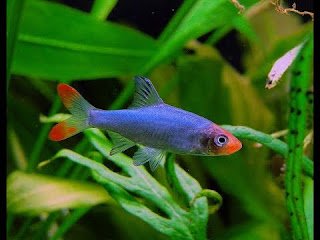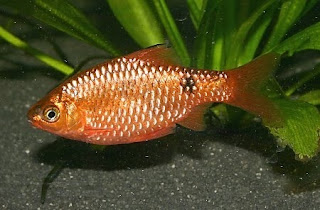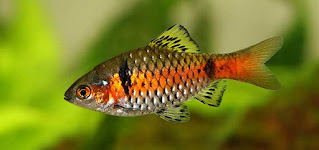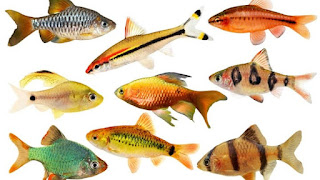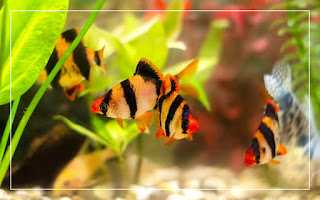Barb's are freshwater fish native to Europe Africa and Asia they get their name from having barbells near their mouth they are hearty colorful and great schooling fish Barb's tend to be very active fish so they do well with more boisterous companions caution should be made when putting bars with slow-moving timid or long-finned fish.
Probably the most popular and recognizable barb in the hobby the tiger barb comes from Borneo and Indonesia and they come in a variety of colors including green black gold and albino with some even having long fins were once one of the top ten fish to be imported however thanks to captive breeding most are commercially farmed females can spawn up to five hundred eggs every two weeks.
It can become aggressive in numbers less than five and so larger groups are recommended they do best in soft acidic water however their natural habitat fluctuates throughout the year so they have a wide tolerance of water parameters they are omnivorous and will accept almost any food however they can become food aggressive so be sure take mates are getting food as well do Desa barb which is sometimes confused, with the less colorful ticked.
Oh, the barb is native to Southeast Asia and was only recently described scientifically in 2008. The Odesa Bar is an active and generally peaceful fish that can be kept in the community aquarium like most Barb's they are a schooling fish so if they are kept in smaller numbers they can become aggressive a highly aggressive eater that will eat almost any type of food however it would appreciate live and frozen foods often it gets its name Odesa because they first appeared in the hobby and Odesa Ukraine in the early 1970s they can't reach sizes up to 3 inches prefer a pH of 6.0 to 7.5 and temperatures ranging from the mid to upper 70s an undemanding fish that can live up to 5 years the rosy bark a subtropical fish found in southern Asia from Afghanistan to Bangladesh one of the largest Barb's on my list they can grow up to 6 inches we usually top out around 4 inches in the aquarium being a subtropical species means they can withstand colder temperatures down to the low 60s making them great for outdoor ponds they are omnivorous eating worms insects and have been known to nibble on plants which is why these are number three on my list the rosy barb is one of the few fish that will actually eat black beard algae they are also relatively peaceful for their size and do great and community aquariums hardy beautiful undemanding and eats black beard algae it's easy to see why rosy Barb's are number 3 on my list you the cherry barb native to Sri Lanka and introduced in Mexico in Colombia is number two on my list the cherry barb is threatened in the wild due to over collection in habitat loss however within the last decade it has become farmed in large numbers commercially reaching up to 2 inches in length the
female is a light yellowish tan color while the male exhibits the deep reds cherry Barb's come from heavily shaded shallow calm bodies of water with lots of leaf litter prefers a PH between 6 and 8 and temps ranging in the low to high 70s a great community fish that loves and looks great in planted aquariums it's recommended to either keep all males or two females to one male as the males will constantly chase females one of the easier Barb's to spawn and the female will scatter between 200 and 300 eggs on a plant afterward the adult should be removed as they will prey on the eggs and fry they will hatch and approximately one to two days and be free swimming after four days after five
weeks the fire will be easily identifiable and ready to sell.
The Dennison barb is also known as the torpedo barb or rose line shark comes in at number 1 in a dangerous species endemic to India described by Frances day an army surgeon from England who
later became the inspector in general and Fisheries in India and maimed the fish after Sir William Ineson of South Wales that collection has caused it to become endangered and is it's a single major threat now banned from fishing and export it is now bred in large quantities at commercial facilities another larger species of barb capable of reaching lengths of over six inches as they mature a distinctive green marking on top of the head will start to develop the Denison Barb is a peaceful schooling fish that is best kept in groups of six or more requiring a minimum of at least four feet this fish does best in a six-foot aquarium prefers a pH of around six point eight to seven point eight and a temps ranging from sixty to seventy-seven Barb degrees.
